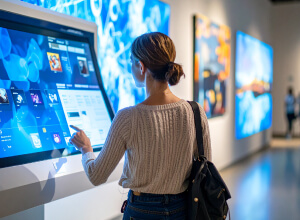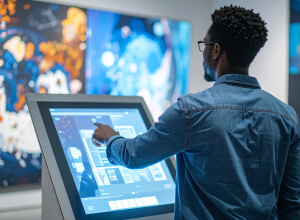Interactive digital signage lessons from 2020

Perhaps this is something we say every time we enter into a new year, but really - what a year it has been!
The year 2020 was inarguably a year full of changes and opportunities at a global level. For some industries, the year offered a wide-open window of opportunities to blossom. For others, the year was a long dark tunnel that didn’t always have an end. Businesses in the interactive signage and kiosk industry had their own shared of this misfortune.
Measures against the spread of Covid-19, such as lockdowns, social distancing, and altered attitudes towards the use of touchscreens, put a halt to the increasing need for public-facing touch-first devices, leaving solution providers with varying degrees of damage.
As the year approached its end, we started to gain some hope that those negatively hit could bounce back and possibly settle into a new normal. But a month into the new year, even that thread of hope doesn’t play easily with the spread of a new virus variant, a slow vaccine rollout, and the increasing spread of the disease.
As much as we might feel fed up talking about the kind of year 2020 was, here’s a pearl of wisdom that always remains true: there are lessons to be learned in all experiences. Why did things pass as they did and what needs to be done to compensate or avoid for those circumstances in the future? It’s better to learn them proactively than to have the lessons imposed on us later.
On that note and before any further ado, let’s walk together through the interactive digital signage lessons from 2020.
Immobility taught us the importance of physical interaction.
With varying degrees of lockdowns, closures, and curfews, immobility had turned from a disability to a mundane lifestyle in 2020. After-work hangouts, eating out with friends and family - as ordinary activities like these have disappeared from real life into a post-COVID to-do list, the lack of physical interactivity and exposure to shared physical environments negatively impacted people’s mental health. (source) While the imposed immobility once again reminded us of our nature as social animals, there is a lesson for business: as many move away from physical engagement, it’s time to redesign and weaponize it. Read here about how companies can offer successful physical engagements while respecting the new way of life.
The relationship between touch interactivity and people took a turn.
When was the last time you saw touchscreen signage or kiosks without at least a hand sanitizer station placed nearby? As much as standard greeting etiquettes like a peck on the cheek or handshakes have nearly turned sinful over the last year, people’s attitudes towards touch-based digital interactivity have been forever altered. We’ll likely never feel completely safe about using them.
Some early movers have started to respond to this turn of events with alternatives to touch interaction, providing visitors with safer alternatives. The approaches are not new but have a renewed level of interest and reduced technology cost.
It was an exciting year for touch-less digital interactivity methods.
Countless interactive technologies, including sensors, deep learning computer vision, audience analytics, touch emulation, and mobile device integration, have become more mature and attainable than ever. While these advancements alone hint at the industry’s readiness for the next chapter, diverse touch-less methods received strong attention amidst the health concerns. Already used across verticals, examples of solutions incorporating advanced interactivity methods include face mask detection and audience analytics, entrance flow management, voice control, speech synthesis-enabled experience, etc.
All the while touchscreen stuck around.
Old habits die hard - at least we can say that about our habits with touchscreens. Touchscreens penetrated our lives thanks to the incredible spread of personal devices, including mobile phones, tablets, and now touchscreen laptops. Ironically, we clung even more to touchscreens with the pandemic as the new lifestyle demanded a substitute for human interaction. For as long as touch remains a significant part of the way we live, we will expect the same from public-facing installations. Besides, countless public places such as QSRs, government offices, airports, and retail stores have long depended on touchscreen solutions to function efficiently and accurately; it’s unlikely that alternatives will fully replace touch interactions. Touchscreens will stay, but the rules are going to change. Read our touchscreen guidance for (post) confinement world.





